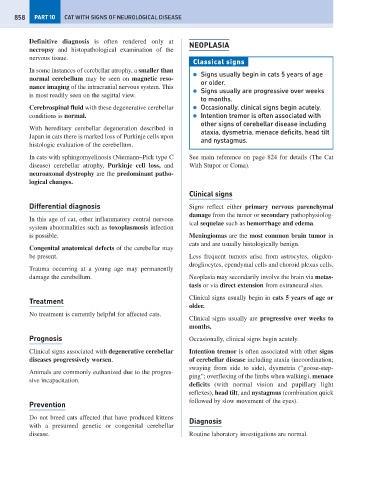Page 866 - Problem-Based Feline Medicine
P. 866
858 PART 10 CAT WITH SIGNS OF NEUROLOGICAL DISEASE
Definitive diagnosis is often rendered only at
NEOPLASIA
necropsy and histopathological examination of the
nervous tissue.
Classical signs
In some instances of cerebellar atrophy, a smaller than
● Signs usually begin in cats 5 years of age
normal cerebellum may be seen on magnetic reso-
or older.
nance imaging of the intracranial nervous system. This
● Signs usually are progressive over weeks
is most readily seen on the sagittal view.
to months.
Cerebrospinal fluid with these degenerative cerebellar ● Occasionally, clinical signs begin acutely.
conditions is normal. ● Intention tremor is often associated with
other signs of cerebellar disease including
With hereditary cerebellar degeneration described in
ataxia, dysmetria, menace deficits, head tilt
Japan in cats there is marked loss of Purkinje cells upon
and nystagmus.
histologic evaluation of the cerebellum.
In cats with sphingomyelinosis (Niemann–Pick type C See main reference on page 824 for details (The Cat
disease) cerebellar atrophy, Purkinje cell loss, and With Stupor or Coma).
neuroaxonal dystrophy are the predominant patho-
logical changes.
Clinical signs
Differential diagnosis Signs reflect either primary nervous parenchymal
damage from the tumor or secondary pathophysiolog-
In this age of cat, other inflammatory central nervous
ical sequelae such as hemorrhage and edema.
system abnormalities such as toxoplasmosis infection
is possible. Meningiomas are the most common brain tumor in
cats and are usually histologically benign.
Congenital anatomical defects of the cerebellar may
be present. Less frequent tumors arise from astrocytes, oligden-
drogliocytes, ependymal cells and choroid plexus cells.
Trauma occurring at a young age may permanently
damage the cerebellum. Neoplasia may secondarily involve the brain via metas-
tasis or via direct extension from extraneural sites.
Clinical signs usually begin in cats 5 years of age or
Treatment
older.
No treatment is currently helpful for affected cats.
Clinical signs usually are progressive over weeks to
months.
Prognosis Occasionally, clinical signs begin acutely.
Clinical signs associated with degenerative cerebellar Intention tremor is often associated with other signs
diseases progressively worsen. of cerebellar disease including ataxia (incoordination;
swaying from side to side), dysmetria (“goose-step-
Animals are commonly euthanized due to the progres-
ping”; overflexing of the limbs when walking), menace
sive incapacitation.
deficits (with normal vision and pupillary light
reflexes), head tilt, and nystagmus (combination quick
followed by slow movement of the eyes).
Prevention
Do not breed cats affected that have produced kittens
Diagnosis
with a presumed genetic or congenital cerebellar
disease. Routine laboratory investigations are normal.

